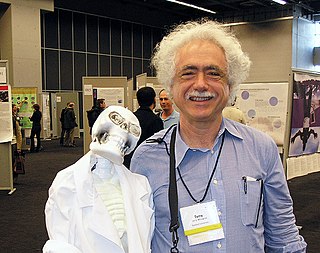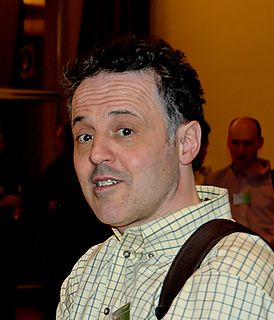Related Research Articles
Logic programming is a programming paradigm which is largely based on formal logic. Any program written in a logic programming language is a set of sentences in logical form, expressing facts and rules about some problem domain. Major logic programming language families include Prolog, answer set programming (ASP) and Datalog. In all of these languages, rules are written in the form of clauses:
Planner is a programming language designed by Carl Hewitt at MIT, and first published in 1969. First, subsets such as Micro-Planner and Pico-Planner were implemented, and then essentially the whole language was implemented as Popler by Julian Davies at the University of Edinburgh in the POP-2 programming language. Derivations such as QA4, Conniver, QLISP and Ether were important tools in artificial intelligence research in the 1970s, which influenced commercial developments such as Knowledge Engineering Environment (KEE) and Automated Reasoning Tool (ART).
Natural-language understanding (NLU) or natural-language interpretation (NLI) is a subtopic of natural-language processing in artificial intelligence that deals with machine reading comprehension. Natural-language understanding is considered an AI-hard problem.
SHRDLU was an early natural language understanding computer program, developed by Terry Winograd at MIT in 1968–1970. In the program, the user carries on a conversation with the computer, moving objects, naming collections and querying the state of a simplified "blocks world", essentially a virtual box filled with different blocks.

The Common Lisp Object System (CLOS) is the facility for object-oriented programming which is part of ANSI Common Lisp. CLOS is a powerful dynamic object system which differs radically from the OOP facilities found in more static languages such as C++ or Java. CLOS was inspired by earlier Lisp object systems such as MIT Flavors and CommonLoops, although it is more general than either. Originally proposed as an add-on, CLOS was adopted as part of the ANSI standard for Common Lisp and has been adapted into other Lisp dialects such as EuLisp or Emacs Lisp.

Terry Allen Winograd is an American professor of computer science at Stanford University, and co-director of the Stanford Human-Computer Interaction Group. He is known within the philosophy of mind and artificial intelligence fields for his work on natural language using the SHRDLU program.
Interlisp is a programming environment built around a version of the programming language Lisp. Interlisp development began in 1966 at Bolt, Beranek and Newman in Cambridge, Massachusetts with Lisp implemented for the Digital Equipment Corporation (DEC) PDP-1 computer by Danny Bobrow and D. L. Murphy. In 1970, Alice K. Hartley implemented BBN LISP, which ran on PDP-10 machines running the operating system TENEX. In 1973, when Danny Bobrow, Warren Teitelman and Ronald Kaplan moved from BBN to the Xerox Palo Alto Research Center (PARC), it was renamed Interlisp. Interlisp became a popular Lisp development tool for artificial intelligence (AI) researchers at Stanford University and elsewhere in the community of the Defense Advanced Research Projects Agency (DARPA). Interlisp was notable for integrating interactive development tools into an integrated development environment (IDE), such as a debugger, an automatic correction tool for simple errors (via do what I mean software design, and analysis tools.
Neat and scruffy are labels for two different types of artificial intelligence (AI) research. Neats consider that solutions should be elegant, clear and provably correct. Scruffies believe that intelligence is too complicated to be solved with the sorts of homogeneous system such neat requirements usually mandate.

Gregor Kiczales is an American computer scientist. He is currently a full time professor of computer science at the University of British Columbia in Vancouver, British Columbia, Canada. He is best known for developing the concept of aspect-oriented programming, and the AspectJ extension to the Java programming language, both of which he designed while working at Xerox PARC. He is also one of the co-authors of the specification for the Common Lisp Object System, and is the author of the book The Art of the Metaobject Protocol, along with Jim Des Rivières and Daniel G. Bobrow.

Wallace "Wally" Feurzeig was an American computer scientist who was co-inventor, with Seymour Papert and Cynthia Solomon, of the programming language Logo, and a well-known researcher in artificial intelligence (AI).
The language/action perspective (LAP) "takes language as the primary dimension of human cooperative activity," applied not just in person-to-person direct (face-to-face) interactions, but also in the design of systems mediated by information and communication technology. The perspective was developed in the joint authorship of Understanding Computers and Cognition by Fernando Flores and Terry Winograd in 1987.
CommonLoops is an early programming language which extended Common Lisp to include Object-oriented programming functionality and is a dynamic object system which differs from the OOP facilities found in static languages such as C++ or Java. Like New Flavors, CommonLoops supported multiple inheritance, generic functions and method combination. CommonLoops also supported multi-methods and made use of metaobjects. CommonLoops and New Flavors were the primary ancestors of CLOS. CommonLoops was supported by a portable implementation known as Portable CommonLoops (PCL) which ran on all Common Lisp implementations of the day.
STUDENT is an early artificial intelligence program that solves algebra word problems. It is written in Lisp by Daniel G. Bobrow as his PhD thesis in 1964. It was designed to read and solve the kind of word problems found in high school algebra books. The program is often cited as an early accomplishment of AI in natural language processing.
Paradigms of AI Programming: Case Studies in Common Lisp (ISBN 1-55860-191-0) is a well-known programming book by Peter Norvig about artificial intelligence programming using Common Lisp.
Frames are an artificial intelligence data structure used to divide knowledge into substructures by representing "stereotyped situations". They were proposed by Marvin Minsky in his 1974 article "A Framework for Representing Knowledge". Frames are the primary data structure used in artificial intelligence frame language; they are stored as ontologies of sets.

Rajeev Motwani was a professor of Computer Science at Stanford University whose research focused on theoretical computer science. He was an early advisor and supporter of companies including Google and PayPal, and a special advisor to Sequoia Capital. He was a winner of the Gödel Prize in 2001.

Carl Eddie Hewitt is an American computer scientist who designed the Planner programming language for automated planning and the actor model of concurrent computation, which have been influential in the development of logic, functional and object-oriented programming. Planner was the first programming language based on procedural plans invoked using pattern-directed invocation from assertions and goals. The actor model influenced the development of the Scheme programming language, the π-calculus, and served as an inspiration for several other programming languages.
The Winograd Schema Challenge (WSC) is a test of machine intelligence proposed by Hector Levesque, a computer scientist at the University of Toronto. Designed to be an improvement on the Turing test, it is a multiple-choice test that employs questions of a very specific structure: they are instances of what are called Winograd Schemas, named after Terry Winograd, professor of computer science at Stanford University.
Larry Melvin Masinter is an early Internet pioneer and ACM Fellow. After attending Stanford University, he became a Principal Scientist of Xerox Artificial Intelligence Systems and author or coauthor of 26 of the Internet Engineering Task Force's Requests for Comments.
Michael Genesereth is a logician and computer scientist, who is most known for his work on computational logic and applications of that work in enterprise management, computational law, and general game playing. Genesereth is professor in the Computer Science Department at Stanford University and a professor by courtesy in the Stanford Law School. His 1987 textbook on Logical Foundations of Artificial Intelligence remains one of the key references on Symbolic artificial intelligence. He is the author of the influential Game Description Language (GDL) and Knowledge Interchange Format (KIF), the latter of which led to the ISO Common Logic standard.
References
- ↑ Oral history interview with Terry Winograd at Charles Babbage Institute, University of Minnesota, Minneapolis.
| This programming-language-related article is a stub. You can help Wikipedia by expanding it. |